Understand the Asymmetric Risk
AMM Pools
Liquidity pools are a core component of decentralized finance (DeFi), enabling trading on decentralized exchanges (DEXs) like Uniswap or SushiSwap. They’re essentially pools of funds, where users (liquidity providers) deposit pairs of cryptocurrencies (e.g., ETH/USDT) to facilitate trading. We, at Splinterlands, are no stranger to Liquidity Pools (LP from now on). DEXs use an Automated Market Maker (AMM) model, where prices are determined by a mathematical formula, typically the constant product formula:
x * y = k
Here, x and y are the quantities of the two tokens, and k s a constant.
The relationship between the two tokens can be visualized by a Constant Product Curve.
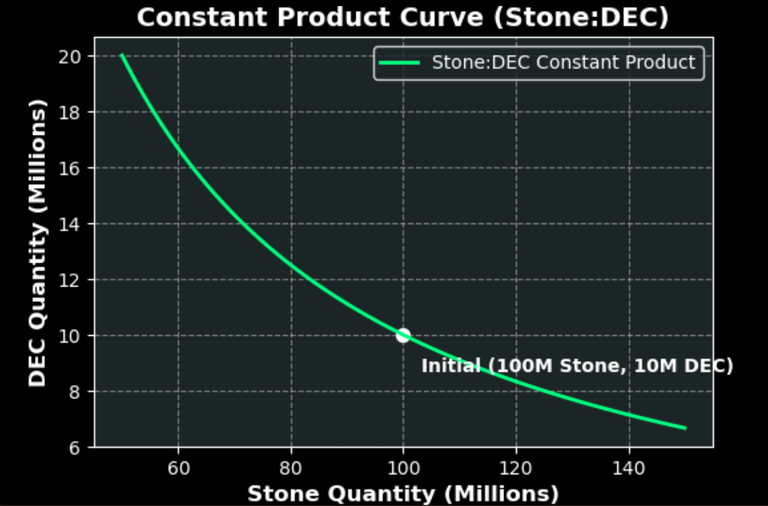
We are going to use the in-game product Stone:DEC pool to understand the details of an AMM pool. Today the price of Stone is:
1 Stone = 0.1 DEC
We can use this price to create an imaginary AMM constant product pool. The green curve here signifies the constant product curve or k. We can assume a scenario so that no new resource is added or subtracted to the pool, but doe to supply-demand (read new in-game features) price of the stone increases or decreases. We also assume that DEC is mostly at peg or near peg at 1000 DEC = $1. With these assumption in place we can investigate the scenarios where Stone goes up or down a lot say 2X!
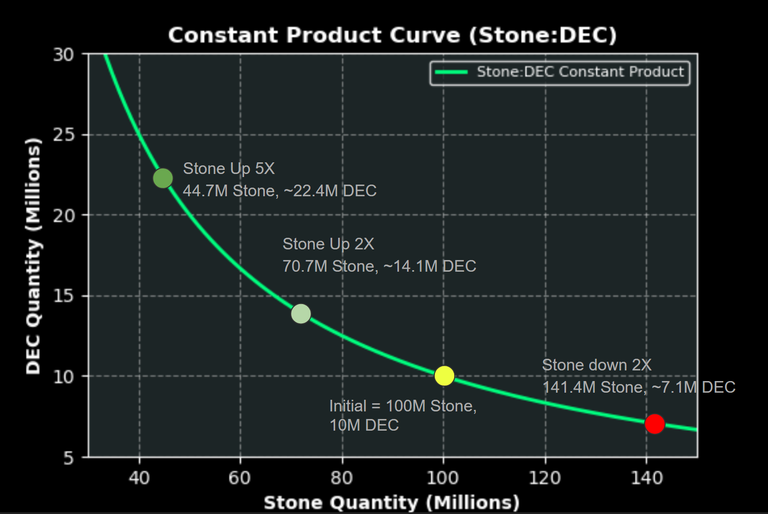
In these scenarios shown on the plot, the size of ones share the pool remains the same. Due to the change of price, the pool automatically sells Stone for DEC if price of stone goes up. So the pool has more DEC than initial position. It does the opposite if price of stone goes down. Same thing happens to every stakeholders in the LP who owns proportional share.

Impermanent Loss
Impermanent Loss (IL) is the potential loss in value experienced by liquidity providers (LPs) in an Automated Market Maker (AMM) liquidity pool, such as the Stone:DEC pool, when the price of the pooled tokens diverges from their initial price ratio at the time of deposit, compared to simply holding the tokens outside the pool. It occurs because AMMs, using a constant product formula (x * y = k ), automatically rebalance the pool’s token quantities as prices change, causing LPs to hold more of the depreciating token and less of the appreciating one.
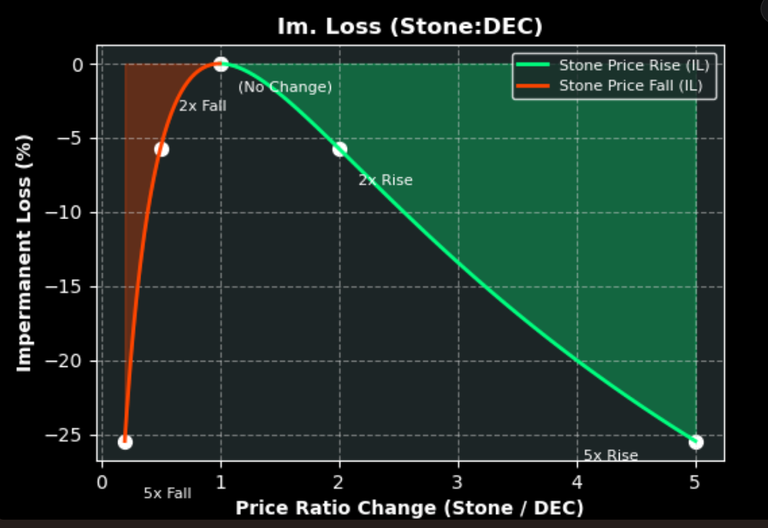
For example, in the Stone:DEC pool (1 Stone = 0.1 DEC initially, DEC stable at 1,000 DEC = $1). If someone deposits 100,000 Stone and 10,000 DEC (total $10), he/she holds $10 worth of stone and $10 worth of DEC, a total of $20 worth of total assets.
Now let us assume a 2x price rise of Stone to 0.2 DEC results in a pool value of ~$28.28 (70,710 Stone and 14,142 DEC), while holding just Stone yields $30 ($10 worth of stone now worth $20, plus $10 worth of DEC), incurring a ~5.7% IL.
The loss is "impermanent" because it’s only realized upon withdrawal and can diminish if prices revert to the initial ratio. The plot illustrates IL for 2x and 5x price changes, showing losses of ~5.7% and ~25.5%, respectively, highlighting the risk in volatile markets.
Important thing to note: IL is higher as the price departs more from the initial price.

But! We get the fees!
Right! You do. If you own 1% of the AMM pool for example, and if the pool pays 5% of the trading fees to the shareholders, that accumulates quickly. Yes? Think again. You must warm up to a concept of asymmetric risk.
Asymmetric Risk in the context of impermanent loss (IL) in the Stone:DEC liquidity pool refers to the uneven risk-reward profile faced by liquidity providers (LPs) compared to simply holding tokens.
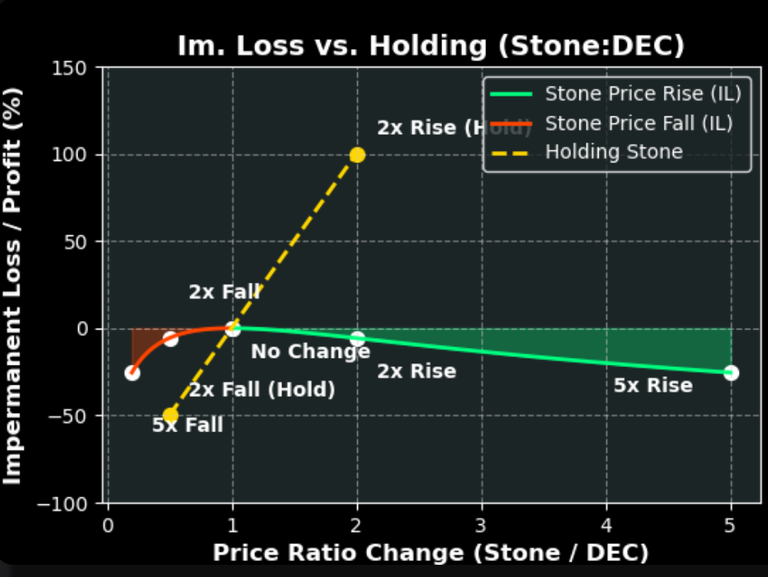
The 5% LP fee (from the 10% swap fee) can offset IL, but as calculated, offsetting a 5.7% IL for a 2x rally requires $11,400 in swap volume for a $200 stake (1% of a $20,000 pool). With a monthly trading volume of $14,000, fees are only ~$7 for a 1% LP (0.01 × 0.05 × $14,000), far short of the $57 needed, making IL a persistent risk.
In other words, if you hold $100 worth of stone (other is $100 worth of DEC which doesn't move lets say), and stone rally 2X, you now have $200 worth of stone plus $100 of DEC, a total of $300. But the same Stone and DEC left in the pool for 1 month after a 2X rally, now the total pool is worth $28,284. The 1% share of that is $282.84. Plus there is the $7 worth of fee, making the total to $282.84 + 7 = $289.84
Folks, that is less then $300, if you have done nothing and hold. I have highlighted the simplest scenario and perhaps the best case scenario. Everything else and higher volatility will make it worse.
PS. I don't want to sound Mr. Obvious, but if I am speculating rapid rally in the price of stone (or anything for the matter), why I would hold $100 worth of stone and $100 worth of DEC? I would just swap the DEC to stone and hold $200 worth of stone. Now with the 2X move, I might have $400 worth of stone, as opposed to $289.84 in the pool!
OUCH!
I want to add these two updated plots for the record, as they capture the exact numbers of Stone:DEC pool as of today
| Constant Product Curve | Impermanent Loss (IL) Curve |
|---|---|
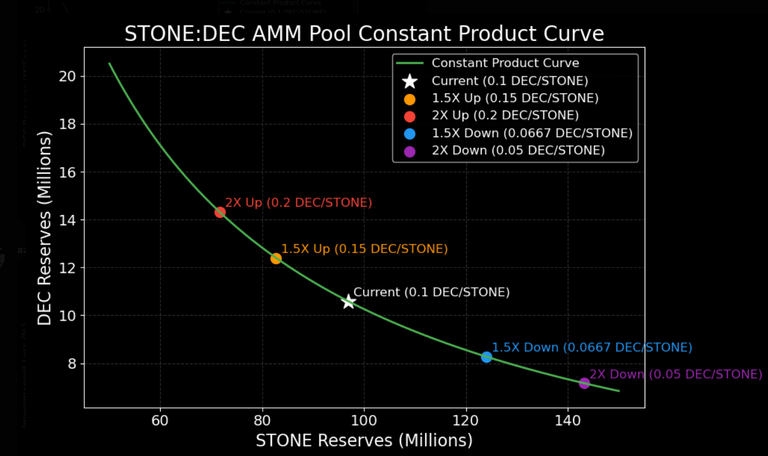 | 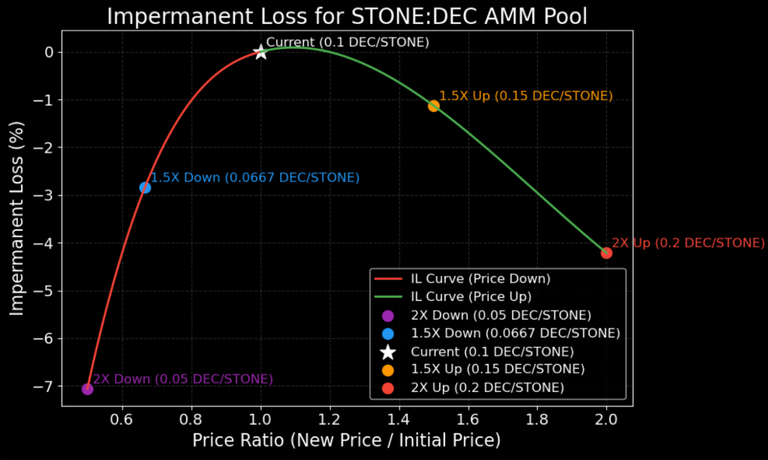 |



I didn't realize they created pools for the resources like that. Or were you just using that as an example? I'm going to have to go look tomorrow now...
All pools are created this way. In fact AMM pools are most common DeFi instruments everywhere.
Right, I just meant that I didn't realize Splinterlands land resources could be pooled this way.
What about grain DEC pool? Is that even worse? Sounds like I should pull out everything from that pool and redeploy the funds somewhere else?
All AMM pools are created this way. Not just in Splinterlands but everywhere.
All pools underperform a sharp rally of assets prices and they do good when market goes sideways on high trading volume.
That makes sense, thank you for the simple explanation.
No you shouldn’t just put funds out. This market can go sideways for a very long time and then the pools will outperform outright holding of assets
Very informative post! As we already discussed on Discord, this is a topic that’s quite hard to fully grasp, in my opinion. Even if you understand the mechanics, assessing the actual risk is tough due to the uncertainty of how the resource tokens will evolve over time.
With a fixed-price token like DEC, it feels like there’s high risk without necessarily offering high reward. The real benefit seems to come during stable, sideways price action with high volume.
That said, I do think this is an important feature within the land game mechanics—it adds flexibility by making it easier to swap for other rewards. 🙂
Absolutely. It is very important and a DEX in-game is really cool. I don't think any other games have it. Since I own a lot of wood, I think I will take some of that asymmetrical risk for the greater good :)
Hi, it's great that AMMs automatically rebalance the amount of tokens in the pool based on price fluctuations. Nice post, my friend.😀
That is great and surprising, thought I was suspicious about the pools after my second land math post. Two things to say though:
You'd get 90$ worth of stone for 100$ worth of DEC, as there's the 10%. Then after appreciating to $380, if you want to swap back, you pay another $38 for fees, so you have a realized gain of $342, not $400. Still, better than the $289 from the pool.
Second, at least with resources: There's also the savings that one can get my not transferring resources from one region to the next, but using the 30-day-period to transfer them without any cost, by withdrawing from the pool into a different region.
That said, thank you so much for this post! I had to read through it a couple of times and probably don't get everything yet, but that was of quite a value to me.
Yes. Fees eat up a lot. However the fees are there for a reason. Without the fees there are no incentives to put resources in the pool.
AMM pools are a fundamental aspect of De-Fi, so it is important to understand them properly.
IMO "impermanent loss" is a clever marketing gimmick created by some of the early AMM designers to fool unwary investors (or possibly those designers were really just that stupid).
"Impermanent losses" are actually just normal unrealized losses, but this scammy name tries to fool people into not believing their own eyes.
I call it "permanent loss" :)
but I am in the minority.
Between you and me, these kind of gimmicks are the reason crypto is still not taken seriously after 15 years! If you look at technology trends, many technology rise and mature from its infancy in 15 years. Not crypto.